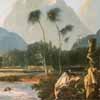 Text search Text search
 Related images Related images
 HistoryWorld HistoryWorld
 Link Link
 Map Map
Click the icons to visit linked content. Hover to see the search terms. |
|  |
| | | | | | | |
|
| 1596 |
| | | Tycho Brahe enters the service of the emperor Rudolf II in Prague, where he invites Johannes Kepler to join him | |    
| |
|
| 1609 |
| | | Johannes Kepler, in Prague, puts forward the radical proposition that the planets move in elliptical rather than circular orbits | |   
| |
|
| 1610 |
| | | Galileo, with his new powerful telescope, observes the moons of Jupiter and spots moving on the surface of the sun | |   
| |
|
| 1613 |
| | | Galileo publishes his evidence, from sun spots, proving Copernicus right and Ptolemy wrong on the solar system | |    
| |
|
| 1632 |
| | | The Inquisition convicts Galileo of heresy and he denies the truth of Copernicus - on being shown the instruments of torture | |   
| |
|
| 1655 |
| | | Christiaan Huygens, using a home-made telescope, describes accurately the rings of Saturn and discovers the planet's largest moon, Titan | |   
| |
|
| 1672 |
| | | Giovanni Domenico Cassini, working in the Paris royal observatory, calculates the distance from the earth to the sun and is only 7% out | |  
| |
|
| 1680 |
| | | A comet intrigues Edmund Halley, who works out that it has been around before | |   
| |
|
| 1758 |
| | | A comet returns exactly at the time predicted by English astronomer Edmond Halley, and is subsequently known by his name | |   
| |
|
| 1769 |
| | | Captain Cook observes in Tahiti the transit of Venus, the primary purpose of his voyage to the Pacific | |   
|  | Hodges Tahiti Revisited (detail)
National Maritime Museum
|
|
|
| | | | | |
| |